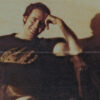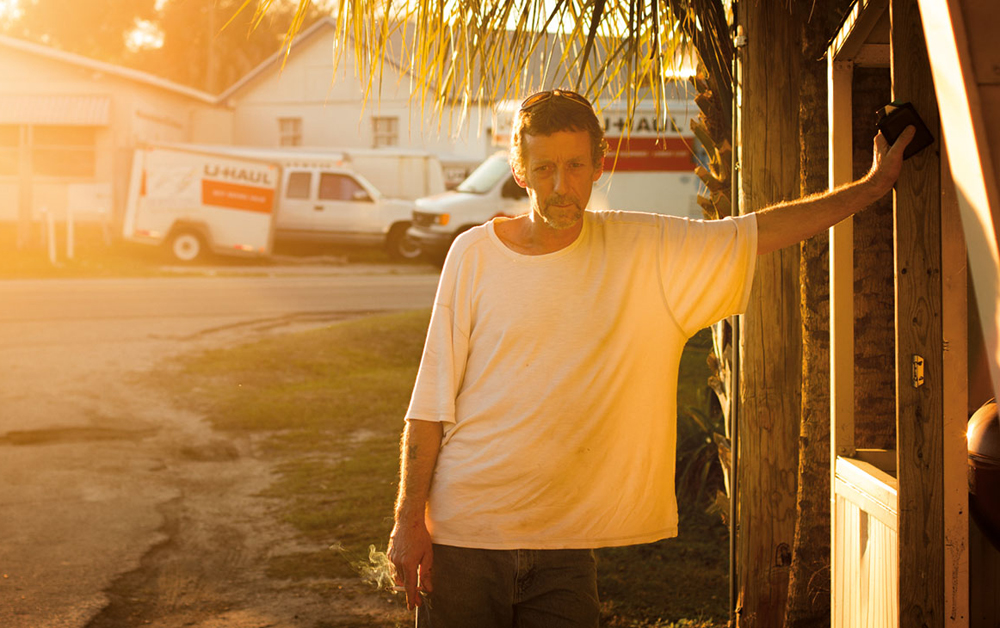Like far too many, Lasse Barkfors’ most vivid impression of sex offenders came from watching the old Dateline NBC show “How to Catch a Predator.”
“These people are entrapped by the police and they’re labeled for life,” recalled Barkers, who put far more thought into the program than most. “I was really thinking this show is a weird form of entertainment.”
He’d have no idea just how surreal it was until he and his wife Frida Barkfors ventured to Florida Justice Transitions, a trailer park in St. Petersburg where the residents are exclusively sex offenders. Founded by Nancy Morais, whose own son had been convicted of a sex crime and saw the difficulty of putting together a life after prison, it’s a place where the residents don’t have to worry about violating their parole by being within 1000 feet of where children congregate and can find a supportive community that will help their rehabilitation. As far as the ex-cons were away from society, the Barkfors felt equally distant, subsequently making a film as far as one can get from the sensationalized treatment that sex crimes often receive.
Instead, with “Pervert Park,” they offer a sobering, clear-eyed look at the vicious cycle that sex offenders fall into, both in trying to become productive citizens once more when their rap sheet all but prevents it and how their crimes, some serious, some not, are often the result of sexual abuse they suffered themselves when they were young. With great observation and even greater sensitivity, the Barkfors get to know members of the clandestine community, capturing their humanity that hasn’t yet hardened either because of what they’ve done or how they’ve been treated in the outside world.
It’s been a long road for the filmmakers since first being intrigued with the community over six years ago, one that now includes a Special Jury Prize from Sundance and numerous plaudits on the festival circuit since and with the film’s American release finally here this week at the IFP Made in NY Media Center in New York, the pair spoke about having their own preconceptions about sex offenders upended, developing a style that would let the film’s subjects stand out, and earning their trust.
Frida Barkfors: It started completely different than how it ended for us. We read this article about the park in a Danish newspaper in 2010, describing it as something completely different than [what we experienced] — a parallel society created by these sex offenders because they couldn’t find a place to live. That caught our interest, the [idea of a] parallel society because we didn’t know anything about the issue of sexual abuse. We had completely bought into the portrait created by the mainstream media. So we went [to Florida] to do some research and to gain access and just talking to the sex offenders completely changed the film. We realized there’s so much more to tell than what is told today [in the mainstream] and we thought it was much more important to tell the story of abusers who could give perspective on how victims turn into abusers and how it can be passed on throughout generations than of the [idea of a] parallel society, which turned out not to exist because they really try hard to reintegrate into society.
Was it obvious to keep it self-contained? To the film’s benefit I felt, you don’t venture outside the park often.
Frida Barkfors: Yeah, we decided very early on not to do that. There are many good films out there already dealing with the topic by talking to the victim and/or expert and we’re not journalists, we’re filmmakers, so that type of documentary didn’t interest us. We felt that by giving a voice to the people who are normally not heard, we could broaden the discussion.
Lasse Barkfors: [Many of the sex offenders are] also victims themselves, so in a way the victims are in the film.
You first visited the park in 2010, but filming happened in 2014. Did it actually take that long to earn trust?
Lasse Barkfors: Actually, it was much more about financing the film because it turned out to be [nearly] impossible. We were working with two different production companies in Sweden and Denmark, and we had to find the funding. In the end, we just took the money that we had in our pocket and we went there and then we were lucky to come back to get the financing for the post-production.
Frida Barkfors: In hindsight, it was a good thing because we did grow and mature. We became parents during this process and reading a lot about it, of course, helped when we made the final film.
Lasse Barkfors: During the four years, we also stayed in contact with the people in the park [while we were looking for financing], so when we came back, they knew how much we actually wanted to make this film and that made them see how much we were going to fight for it.
Frida Barkfors: [Also, a film] is not something that is typical for sex offenders and [in general] it’s healthy to have some kind of skepticism at the beginning when people come in and say they want to make a film about you. But sex offenders have it to a higher degree because they’re used to being labeled, so once you prove you’ll listen to them and see them more as people than as a label, of course they’ll open up to a greater extent because it’s probably one of those few times that they’re met with someone who are willing to listen without judging.

Frida Barkfors: Tracy was an exception because she had not gone to therapy. Don, the [park’s] therapist, knew the details of her case, but she has never talked about it before and she was very hesitant in talking to us. We had to work at getting her trust. She said “yes,” then she changed her mind and then ended up saying yes in the end, so when we interviewed with her, it was the very first time she told her story. But many of the others had told their story many times in therapy, so it was quite the opposite. For instance with William [J. Fuery, another subject who became the maintenance and security man at the park], I remember, that he was so used to telling his story — I wouldn’t say that he was emotionally detached, but if you talk about something many times, you can’t get emotionally affected every time because it would be too draining, so he would tell us stuff where I would have to stop him and say, “No, wait a minute. We’re going to come back to that,” so that we could get the details and the emotion because if I didn’t guide him, it would come out as sounding cold although I know he’s very much affected by what happened in his life. But it was very, very important for us not to have a strong editorial voice where the viewers would feel like we’re trying to tell them what to think, so we worked a lot with the structure.
Lasse Barkfors: Actually, the whole idea of how to edit it came from the idea that we wanted to try to make the viewer go through the same feelings that we did when we were there shooting the film. We were so confused with emotions towards these people because they would be scared and angry, and we would laugh and cry with them. There was so much emotion going on so that had to be in the film.
The film is very subtle yet effective stylistically through it’s use of voiceover and accompanying imagery of the day-to-day lives of the park’s residents. How did that come about?
Frida Barkfors: We didn’t actually mean to use as many talking heads as we ended up doing, but we wanted to have more of everyday life scenes because for us it was important to show that these are people like everyone else. I can’t stress enough that the most important thing for us was to make this film without minimizing their crimes. It’s not like we’re excusing what they did, but we were trying to understand if there’s a better way of dealing with sexual abuse in order to stop it and we wanted these everyday life scenes because that is what makes them human. They’re doing all the stuff that I’m doing or that other people do. We also realized when we were talking to them that they just couldn’t tell [some of their stories] on camera, so when Tracy talks about her experience, we would have it as a voice over. We always went with what felt emotionally and morally right from a filmmaker standpoint and if it ended up being less visually inspiring, then so be it. It was more the about humanization.
Lasse Barkfors: We didn’t know it would be this powerful, but it turned out to work very well.

Frida Barkfors: It’s really this difficult to answer because I can’t remember if there was a [specific] point. It happened all the time [since] we never set out looking for an answer, like we had some theories or a statement [to make] about sex offenders that we set out to prove. It was more like we don’t know enough about this, so we’re going to learn about it after we went to the park the first time. We were really just trying to understand and that’s also a technique we used in the interviews — it was more of a conversation than an interview. We also made a decision that we didn’t want to make an activist film because we didn’t want to preach to the choir. Both Lasse and I believe that [if we made a film] to solve a problem here and now, it’s not going to work for very long.
Lasse Barkfors: We can’t do it by making a film, but we can contribute to the discussion.
Frida Barkfors: That’s the thing. Maybe the laws would’ve been changed, but the views on sex offenders would still be the same. We felt that it was much more important to say there’s more to the story than what is told today. The people who are ending up abusing kids are not all sick pedophiles — it’s a very small amount of them that are, and these people can be helped before they act out. We [also present the fact] that the laws have been passed for the last 20 years are destroying people’s lives — not only sex offenders, but also their friends and family and the way we are treating sex offenders today is actually is part of the problem.
What’s it been like to travel with the film and see the reaction?
Frida Barkfors: It’s been quite overwhelming for Lasse and I because we didn’t expect people to like it. When we got into Sundance, it was a big surprise for us.
Lasse Barkfors: We were sure they’re going to throw eggs and tomatoes at us.
Frida Barkfors: Surprisingly, people have been open-minded and the response we’ve gotten had been really positive from the reviews to the people coming up to us afterwards — if they hated it, they didn’t tell us. We’ve met people that have some personal connection to the topic and we still keep in contact with people who live in the park, and they said that they’ve already had people reaching out to them. One woman wrote [one of] them to say, “I’m really sorry. I apologize for judging you,” so it’s already had a surprisingly positive effect on some people.
“Pervert Park” opens on May 20 in New York at IFP’s Made in NY Media Center.





